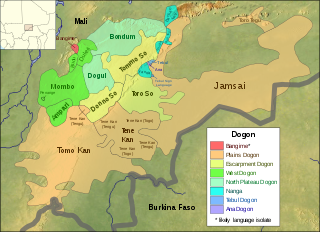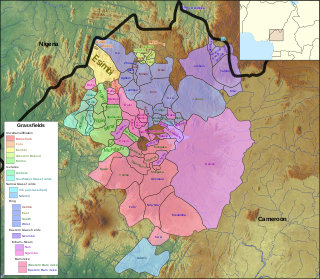Related Research Articles
Tone is the use of pitch in language to distinguish lexical or grammatical meaning – that is, to distinguish or to inflect words. All verbal languages use pitch to express emotional and other paralinguistic information and to convey emphasis, contrast and other such features in what is called intonation, but not all languages use tones to distinguish words or their inflections, analogously to consonants and vowels. Languages that have this feature are called tonal languages; the distinctive tone patterns of such a language are sometimes called tonemes, by analogy with phoneme. Tonal languages are common in East and Southeast Asia, Africa, the Americas and the Pacific.

Zulu, or isiZulu as an endonym, is a Southern Bantu language of the Nguni branch spoken in Southern Africa. It is the language of the Zulu people, with about 12 million native speakers, who primarily inhabit the province of KwaZulu-Natal of South Africa. Zulu is the most widely spoken home language in South Africa, and it is understood by over 50% of its population. It became one of South Africa's 11 official languages in 1994.
The Ganda language or Luganda is a Bantu language spoken in the African Great Lakes region. It is one of the major languages in Uganda and is spoken by more than 10 million Baganda and other people principally in central Uganda including the capital Kampala of Uganda. Typologically, it is an agglutinative, tonal language with subject–verb–object word order and nominative–accusative morphosyntactic alignment.
A pitch-accent language, when spoken, has word accents in which one syllable in a word or morpheme is more prominent than the others, but the accentuated syllable is indicated by a contrasting pitch rather than by loudness, as in many languages, like English. Pitch-accent also contrasts with fully tonal languages like Vietnamese and Standard Chinese, in which each syllable can have an independent tone. Some have claimed that the term "pitch accent" is not coherently defined and that pitch-accent languages are just a sub-category of tonal languages in general.
Gǀui or Gǀwi is a Khoe dialect of Botswana with 2,500 speakers. It is part of the Gǁana dialect cluster, and is closely related to Naro. It has a number of loan words from ǂʼAmkoe. Gǀui, ǂʼAmkoe, and Taa form the core of the Kalahari Basin sprachbund, and share a number of characteristic features, including extremely large consonant inventories.

Northern or North Sámi is the most widely spoken of all Sámi languages. The area where Northern Sámi is spoken covers the northern parts of Norway, Sweden and Finland. The number of Northern Sámi speakers is estimated to be somewhere between 15,000 and 25,000. About 2,000 of these live in Finland and between 5,000 and 6,000 in Sweden, with the remaining portions being in Norway.

Proto-Balto-Slavic is a reconstructed hypothetical proto-language descending from Proto-Indo-European (PIE). From Proto-Balto-Slavic, the later Balto-Slavic languages are thought to have developed, composed of sub-branches Baltic and Slavic, and including modern Lithuanian, Polish, Russian and Serbo-Croatian, among others.
Phuthi (Síphùthì) is a Nguni Bantu language spoken in southern Lesotho and areas in South Africa adjacent to the same border. The closest substantial living relative of Phuthi is Swati, spoken in Eswatini and the Mpumalanga province of South Africa. Although there is no contemporary sociocultural or political contact, Phuthi is linguistically part of a historic dialect continuum with Swati. Phuthi is heavily influenced by the surrounding Sesotho and Xhosa languages, but retains a distinct core of lexicon and grammar not found in either Xhosa or Sesotho, and found only partly in Swati to the north.
The Koti language, or Ekoti, is a Bantu language spoken in Mozambique by about 64,200 people. Koti is spoken on Koti Island and is also the major language of Angoche, the capital of the district with the same name in the province of Nampula.
Sesotho verbs are words in the language that signify the action or state of a substantive, and are brought into agreement with it using the subjectival concord. This definition excludes imperatives and infinitives, which are respectively interjectives and class 14 nouns.
The phonology of Sesotho and those of the other Sotho–Tswana languages are radically different from those of "older" or more "stereotypical" Bantu languages. Modern Sesotho in particular has very mixed origins inheriting many words and idioms from non-Sotho–Tswana languages.
Like most other Niger–Congo languages, Sesotho is a tonal language, spoken with two basic tones, high (H) and low (L). The Sesotho grammatical tone system is rather complex and uses a large number of "sandhi" rules.

Bangime is a language isolate spoken by 3,500 ethnic Dogon in seven villages in southern Mali, who call themselves the bàŋɡá–ndɛ̀. Bangande is the name of the ethnicity of this community and their population grows at a rate of 2.5% per year. The Bangande consider themselves to be Dogon, but other Dogon people insist they are not. Bangime is an endangered language classified as 6a - Vigorous by Ethnologue. Long known to be highly divergent from the (other) Dogon languages, it was first proposed as a possible isolate by Blench (2005). Research since then has confirmed that it appears to be unrelated to neighbouring languages. Heath and Hantgan have hypothesized that the cliffs surrounding the Bangande valley provided isolation of the language as well as safety for Bangande people. Even though Bangime is not related to Dogon languages, the Bangande still consider their language to be Dogon. Hantgan and List report that Bangime speakers seem unaware that it is not mutually intelligible with any Dogon language.
Zulu grammar is the way in which meanings are encoded into wordings in the Zulu language. Zulu grammar is typical for Bantu languages, bearing all the hallmarks of this language family. These include agglutinativity, a rich array of noun classes, extensive inflection for person, tense and aspect and a subject–verb–object word order.
Konkani is a southern Indo-Aryan language belonging to the Indo-European family of languages spoken in the Konkan coastal region of India. It has approximately 3.6 million speakers.
Afitti is a language spoken on the eastern side of Jebel el-Dair, a solitary rock formation in the North Kordofan province of Sudan. Although the term ‘Dinik’ can be used to designate the language regardless of cultural affiliation, people in the villages of the region readily recognize the terms ‘Ditti’ and ‘Afitti.’ There are approximately 4000 speakers of the Afitti language and its closest linguistic neighbor is the Nyimang language, spoken west of Jebel el-Dair in the Nuba Mountains of the South Kordofan province of Sudan.

Babanki, or Kejom, is the traditional language of the Kejom people of the Western Highlands of Cameroon.
Obokuitai (Obogwitai) is a Lakes Plain language of Papua, Indonesia. It is named after Obogwi village in East Central Mambermano District, Mamberamo Raya Regency.
Luganda, the language spoken by the Baganda people from Central Uganda, is a tonal language of the Bantu family. It is traditionally described as having three tones: high, low and falling. Rising tones are not found in Luganda, even on long vowels, since a sequence such as [] automatically becomes [].
Medumba phonology is the way in which the Medumba language is pronounced. It deals with phonetics, phonotactics and their variation across different dialects of Medumba.
References
- 1 2 3 4 5 6 7 8 9 10 11 Crane, Thera M.; Hyman, Larry M.; Tukumu, Simon Nsielanga (2011). A grammar of Nzadi [B865] : a Bantu language of the Democratic Republic of the Congo. Berkeley, CA: University of California Press. ISBN 9780520098862.
- ↑ Jouni Filip Maho, 2009. New Updated Guthrie List Online
- ↑ Hyman, Larry (June 2012). "Post-Verbal subject in the Nzadi relative clause". Journal of African Languages and Linguistics. 33 (1): 97–117. doi:10.1515/jall-2012-0004. S2CID 146842539.